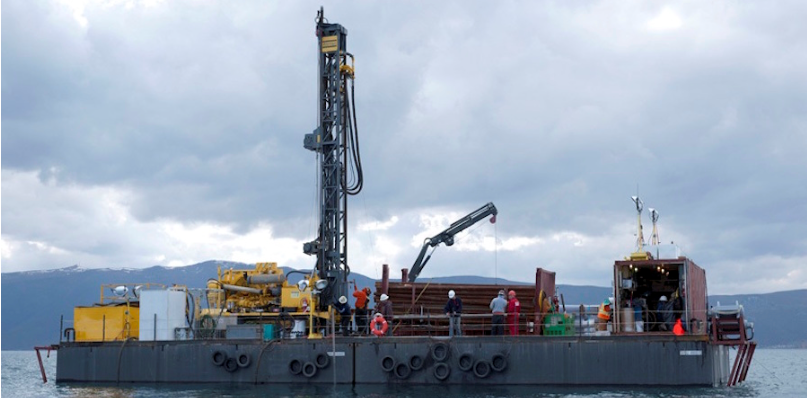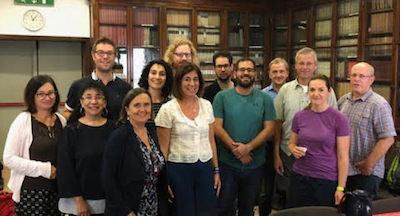Scientific Collaboration on Past Speciation Conditions in Lake Ohrid
The Project
Lake Ohrid in the Balkans (Macedonia, Albania) is a unique aquatic ecosystem and a hotspot of freshwater biodiversity with more than 210 endemic species described. Though the lake is considered to be the oldest, continuously existing lake in Europe, its age and origin are not completely unravelled to date. Age estimations vary between one and ten million years, with a focus between two and three million years, and both marine and limnic origin is proposed. Extant sedimentary records span the last glacial/interglacial cycle (last ca. 130.000 years) and reveal that Lake Ohrid is a valuable archive of volcanic ash dispersal, tectonic activity, and climate change in the central northern Mediterranean region. The current international deep drilling project in Lake Ohrid will thus help to obtain more precise information about the age and origin of the lake, to unravel the seismotectonic history of the lake area, to obtain a continuous record containing information on volcanic activities and climate changes in the central northern Mediterranean region, and to better understand the impact of major geological/environmental events on shaping an extraordinary degree of endemic biodiversity as a matter of global significance. The drilling is conducted in spring 2013 in the central basin where the maximal sediment thickness is ~680 m and where the complete history of the lake is likely recorded.

SCOPSCO Pollen Group
The international team of SCOPSCO (Scientific Collaboration on Past Speciation Conditions in lake Ohrid) has studied the Balkan lake Ohrid to reconstruct past climatic trends. The research was led by Bernd Wagner of the University of Cologne. Lake Ohrid is located at the border between Albania and Republic of North Macedonia and it is considered one of the oldest lakes in Europe. For this reason, in 2013, thanks to a funding of the ICDP (International Continental Scientific Drilling Program), the bottom of the lake was drilled and a sediment core with an impressive length of 600 m was made available to an international team of researchers. The geological coring, carried out in a central position at a water depth of 243 m, represented a technological challenge that required the use of equipment coming from the United States. Sediment layers can be interpreted as pages of a history book that scientists can read. The sediment of Lake Ohrid, slowly accumulated over time, layer by layer, records the history of vegetation and climate of more than one million years, thus preserving the evidence of glacial and interglacial cycles in the Mediterranean. Among the data provided, a significant role was played by the study of fossil pollen preserved in the sediment of this lake, which was studied by a group of Italian,Dutch, French, Greek and German palynologists led by Laura Sadori of the Sapienza University (SCOPSCO pollen group). The team, first to gather such a large number of experts working in synergy on a single archive, described the changes in vegetation that occurred in response to alternating climatic periods. Warm and wet interglacials have allowed the development of forests while cold and arid glacials have mostly been characterized by extensive steppes and grasslands. During the coldest and driest periods, the lake, thanks to its extraordinary environmental conditions, was an area of refuge for many plant and animal species, and today is an important biodiversity hotspot and, since 1979, also a UNESCO site. Thanks to the pollen, which is very peculiar, it was also possible to learn more about the extinction of some characteristic Quaternary plants that are no longer present in the Balkan region.

Unimore pollen group - Published articles on Lake Ohrid
Lake Ohrid research on UNIMORE WebTV & Multimedia Magazine
Donders T., Panagiotopoulos K., Koutsodendris A., Bertini A., Mercuri A.M., Masi A., Combourieu-Nebout N., Joannin S., Kouli K., Kousis I., Peyron O., Torri P., Florenzano A., Francke A., Wagner B., Sadori L., 2021. 1.36 million years of Mediterranean forest refugium dynamics in response to glacial-interglacial cycle strength. PNAS, 118.
https://doi.org/10.1073/pnas.2026111118.
Wagner B. Vogel H., Francke A., Friedrich T., Donders T.H., Lacey J., Leng M., Regattieri E., Sadori L., Wilke T., Zanchetta G., Albrecht C., Bertini A., Combourieu-Nebout N., Cvetkoska A., Giaccio B., Grazhdani A., Hauffe T., Holtvoeth J., Joannin S., Jovanovska E., Just J., Kouli K., Kousis I., Koutsodendris A., Krastel S., Leicher N., Levkov Z., Lindhorst K., Masi A., Melles M., Mercuri A.M., Nomade S., Nowaczyk N., Panagiotopoulos K., Peyron O., Reed J.M., Sagnotti L., Sinopoli G., Stelbrink B., Sulpizio R., Timmermann A., Tofilovska S., Torri P., Wagner-Cremer F., Wonik T., Zhang X., 2019 - Mediterranean winter rainfall in phase with African monsoons during the past 1.36 million years. Nature 573: 256-260
http://www.nature.com/artivles/s41586-019-1529-0
Wagner B., Wilke T., Francke A., Albrecht C., Baumgarten H., Bertini A., Combourieu-Nebout N., Cvetkoska A.m., D'Addabbo M., Donders T.H., Föller K., Giaccio B., Grazhdani A., Hauffe T., Holtvoeth J., Joannin S., Jovanovska E., Just J., Kouli K., Koutsodendris A., Krastel S., Lacey J.H., Leicher N., Leng M.J., Levkov Z., Lindhorst K., Masi A., Mercuri A.M., Nomade S., Nowaczyk N., Panagiotopoulos K., Peyron O., Reed J.M., Regattieri E., Sadori L., Sagnotti L., Stelbrink B., Sulpizio R., Tofilovska S., Torri P., Vogel H., Wagner T., Wagner-Cremer F., Wolff G.A., Wonik T., Zanchetta G., Zhang X.S., 2017 - The environmental and evolutionary history of Lake Ohrid (FYROM/Albania): Interim results from the SCOPSCO deep drilling project. Biogeosciences 14: 2033-2054
https://www.biogeosciences.net/14/2033/2017/
Sadori, L., Koutsodendris A., Panagiotopoulos K., Masi A., Bertini A., Combourieu-Nebout N., Francke A., Kouli K., Joannin S., Mercuri A.M., Peyron O., Torri P., Wagner B., Zanchetta G., Sinopoli G., Donders T.H., 2016 - Pollen-based paleoenvironmental and paleoclimatic change at Lake Ohrid (south-eastern Europe) during the past 500 ka. Biogeosciences 13: 1423-1437.
http://www.biogeosciences.net/13/1423/2016/
Bertini A., Sadori L., Combourieu-Nebout N., Donders T.H., Kouli K., Koutsodendris A., Joannin S., Masi A., Mercuri A.M., Panagiotopoulos K., Peyron O., Sinopoli G., Torri P., Zanchetta G., Francke A., Wagner B., 2016. All together now: an international palynological team documents vegetation and climate changes during the last 500 kyr at lake Ohrid (SE Europe). Alpine and Mediterranean Quaternary 29:201-210
http://amq.aiqua.it/en/issues/directory/items/alpine-and-mediterranean-quaternary-292-2016


